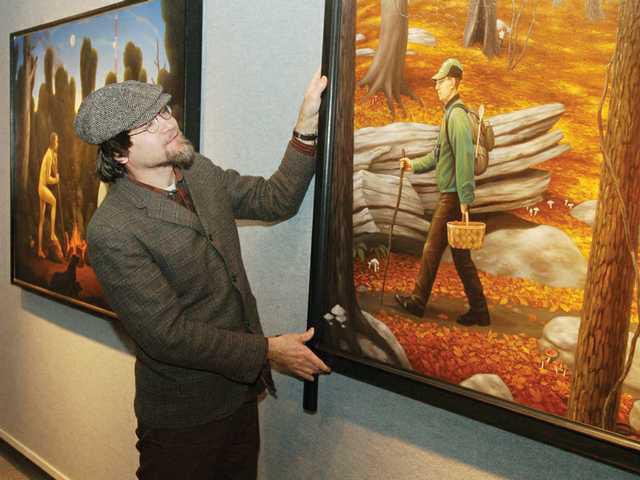‘Moments in Time'
What: Paintings by Terry Rowlett
When: Through Feb. 11; reception noon today
Where: Roy C. Moore Art Gallery, Gainesville State College's Continuing Education Center, 3820 Mundy Mill Road, Oakwood
How much: Free
In Terry Rowlett's painting "The Refugee," a young man, clad in slacks and a button-down shirt, makes his way through a tangle of kudzu.
He drops his satchel to spill his laptop and cell phone upon the ground, enters a firelit clearing and falls exhausted into the welcoming embrace of an angelic barefoot woman. A dark bearded nude male figure gazes approvingly upon the union as a shower of sparks ascends heavenward to the full moon overhead, and a friendly dog curls up in a bonfire's warm glow.
There's certainly a story in this scene, part of Rowlett's current solo exhibit "Moments in Time" at the Roy C. Moore Art Gallery at Gainesville State College, but the artist is reluctant to reveal the details of the narrative. One gets the sense that it's a story no words can tell. The image calls to mind so many ancient and classical scenes and tales in which our hero leaves home to brave the wider world, only to be welcomed back into the fold.
In Rowlett's version, the wider world is barely a glow on the horizon, lorded over by a cell phone tower topped off by a satellite dish mimicking the ancient and magical moon. This hero flees the technology and constant communication of contemporary life to find primeval respite in nature's unfettered tangle.
Rowlett is certainly drawn to classical tales and keeps a stack of renaissance and baroque art history books by his easel to constantly inform the subject and details of his paintings, but his works are of a thoroughly modern world.
"I don't need to know the stories of what's taking place in old paintings. I just love the drama in these (600-) to 700-year-old paintings," explains Rowlett of his ambiguous scenes. "That's what I'm going for - contemporary images that will mystify people in the future."
An Arkansas native, Rowlett spent time in the Army and was stationed in West Germany before the fall of the Berlin Wall. He went on to study art at the University of Arkansas and earned his Master of Fine Arts degree from the University of Georgia in 1995.
Now in his late 40s, Rowlett's early work focused on contemporary reinterpretations of Christian messages, but somewhere along the way he lost his faith.
"I've had more time to question things. I've had enough experience behind me to realize that religion is total mythology and I just stopped believing in the myth," he said of his meandering spiritual path.
"The Christianity gave me so much faith that I was on a mission for Christ for the first 10 years I was painting — it gave me a lot of guts to stay focused on painting. I still have that discipline and I use it for the betterment of the whole human race, whether it's through enlightenment or just pure entertainment."
Rowlett, who has lived in Italy, Israel, New York City, the Hudson Valley, the Catskills and North Carolina over the past dozen or so years, frequently settles back in Athens for extended periods of time. It's a bustling college city teeming with the kind of free-thinking and hyper-creative folk who frequently pop up as characters in his paintings.
"Zarathustra" is actually a portrait of an atheist friend who introduced Rowlett to the work of Friedrich Nietzsche. Upon first glance, it's a gloomy woodland scene of a black-clad figure among barren trees against a clouded sky, but tiny wildflowers spring up underfoot - a subtle allusion to the existentialist's message that life's true beauty reveals itself in our darkest hours.
And the brooding nude of "The Refugee" appears again as a regal thinker overseeing a summertime escapade in "King of the Swimming Hole," and again in "End of Summer" (this time mostly clothed) as a laughing lover reclined on a motorcycle.
Such scenes of unabashed hedonism are actually about "a more natural state in nature," said Rowlett, an interpretation that lends them an air of innocent celebration.
Nature is definitely the leading character in this collection of paintings, and the artist himself acknowledges that its role is not without spiritual implications.
"I'm definitely in league with the pagans. I understand their spirituality more than the other religions," he said.
It's a concept that comes across clearly in "The Green Man," inspired by the myth of the ancient pagan god of the woods. In this scene, he peeks his jack-o'-lantern-like face out from behind a tree as a mushroom-gathering hiker wanders through an autumn wood, oblivious to the critters who are watching — though his canine companion is cautiously aware of the company.
Nearly all of Rowlett's paintings include at least one dog, appropriately so as man's best friend seems a natural go-between with the human realm and that of nature.
"Dogs are my secondary humans — everyone can relate to my dogs," Rowlett said. "They might not like what's going on with my people, but dogs are always instantly accepted."

